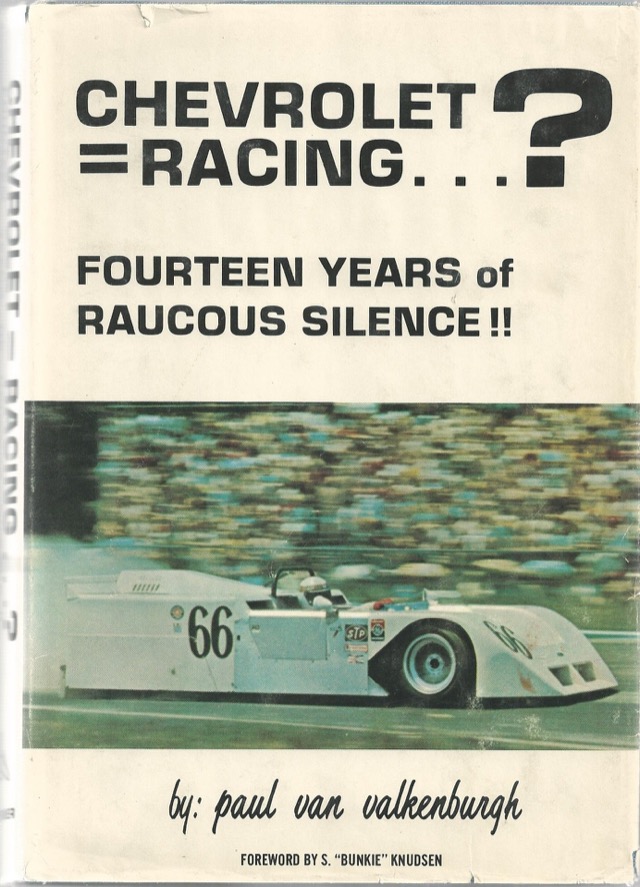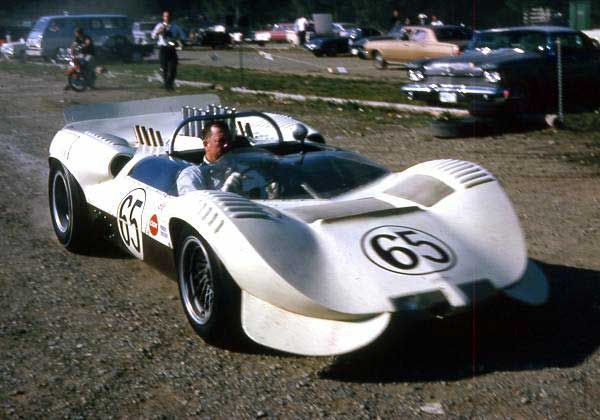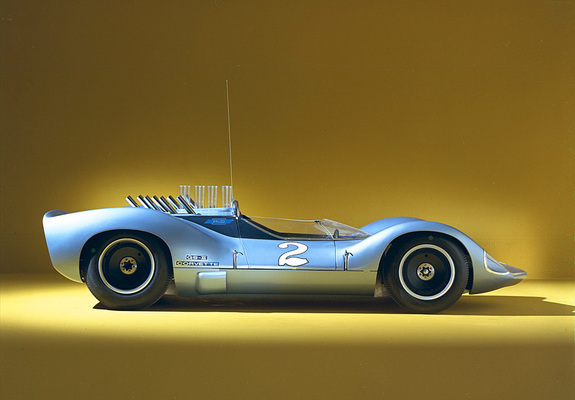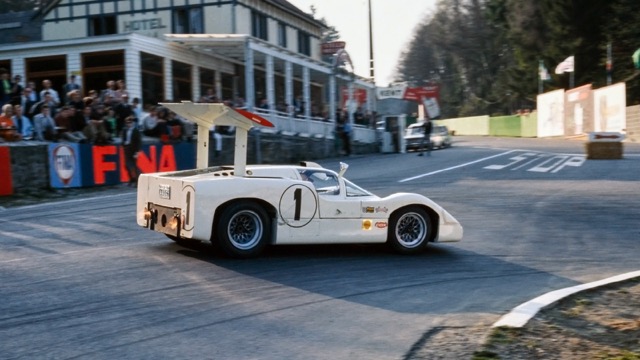Detroit. Racing a car, motorcycle or anything with some sort of power is a pursuit like no other. It is a passionate endeavor requiring an obsessive single-mindedness that consumes the people involved to a degree that outsiders find hard to understand. Ask any driver who has competed at the top level, and they will tell you that there is nothing half-assed about what they do, because the focus required is almost incomprehensible. Drivers talk about being in "the zone" - a strange state of mind that takes over their entire being while they're racing - when the faster they go the more things seem to slow down for them. They're aware of everything around them, but at the same time their focus on the task at hand is impenetrable, because anything less can result in a mistake that will likely have severe consequences. Racers are indeed a rare breed, willing to sacrifice everything for the pursuit of what they love to do, to the detriment of everything else. These racers have left an indelible mark on the sport. Drivers who were fierce competitors, flawed heroes and incredible, gifted talents. Their legacies are what make the sport of motor racing so fascinating. In the next few issues of "Fumes" I will recall some of my favorites.
This week I'd like to focus on Jim Hall and the story of his fabulous Chaparrals, which marked one of the high points of "blue-sky" thinking and advanced technical developments in the sport. Through the course of my Twitter postings, one of my Twitter followers was incredulous to find out that Chevrolet was deeply involved in a technical partnership with Jim Hall, one that was completely kept under the table due to the fact that some of the suits on the famous 14th Floor of the GM Building were decidedly anti-racing.
Though I prefer the way Ford went about its racing in the 60s, which was part of an aboveboard, orchestrated marketing push called "Total Performance," the story of Jim Hall and his Chaparrals and other racing endeavors by GM/Chevrolet Engineering's True Believers and Best and Brightest is one of the most fascinating stories in the history of motorsport. If you can get your hands on Paul Van Valkenburgh's vivid account of those incredible years - "Chevrolet = Racing...? Fourteen Years of Raucous Silence!!" - you will be amazed at the stories and photos documenting Chevrolet Engineering's deep involvement in the Chaparral program, and other racing forays with John Mecom, Roger Penske and a host of others.
The reason I'm bringing this up is that those fourteen years coincided with one of the most creative eras in motorsports history, long before the sport devolved into a maze of restrictions and specifications. I would like to think we can somehow muster a new era of creativity in racing again, but as long as "racing in a vacuum" - whereupon participants only listen to the dulcet tones of their own thought balloons while conveniently ignoring what's going on in the real world - is racing's standard operating procedure, I'm afraid the sport will continue spinning its wheels along the road to its inevitable decline.
With that said, I would like to reflect on Jim Hall, who is one of the most, if not the most, influential innovators the sport has ever seen. Working hand-in-hand with visionaries inside Chevrolet Engineering, Hall pioneered developments in aerodynamic thinking and ground effects that resonate to this day. The impact of Hall's legacy is almost impossible to calculate, as his pioneering concepts influenced racing around the world - and still do to this day. I look forward to the upcoming book by George Levy, Texas Legend: Jim Hall and his Chaparrals, which will add depth and context to Jim Hall's story, but I will offer up a few details and photos this week for your viewing and reading pleasure.
 (Amazon)
(Amazon)
"Chevrolet = Racing...? Fourteen Years of Raucous Silence!!" was Paul Van Valkenburgh's vivid account of GM/Chevrolet Engineering's under the table racing programs. A fascinating read. Elkhart Lake, Wisconsin, 1965. Hap Sharp in the No. 65 Chaparral 2A (with 2C modifications) drives through the paddock @roadamerica. The Chaparral team swept the Road America 500, finishing 1-2.
Elkhart Lake, Wisconsin, 1965. Hap Sharp in the No. 65 Chaparral 2A (with 2C modifications) drives through the paddock @roadamerica. The Chaparral team swept the Road America 500, finishing 1-2. The Corvette GSIIb was the Chevrolet Engineering research version of the Chaparral 2 and its iterations.
The Corvette GSIIb was the Chevrolet Engineering research version of the Chaparral 2 and its iterations.

Spa 1000 Kilometers, May 1, 1967. The Phil Hill/Mike Spence Chaparral 2F Chevrolet 427 started from the pole but DNF due to gearbox issues. 1. Jacky Ickx/Dr. Dick Thompson (Mirage M1 Ford). 2. Jo Siffert/Hans Herrmann (Porsche 910). 3. Richard Attwood/Lucien Bianchi (Ferrari 412 P).
One memorable Jim Hall story is how he always attached Texas license plates to his cars while racing in Europe. And, lost in the huge excitement of Ford winning the 1966 24 Hours of Le Mans, was the fact that Jim Hall's Chaparral Cars racing team delivered a stunning triumph of its own a couple of weeks before at the A.D.A.C. Nurburgring 1000 km at the famous Nordschleife circuit in Germany on June 5, 1966, for Round 6 of the World Sportscar Championship. The prevailing conventional wisdom at the time suggested that the lone American entry from Jim Hall's Midland, Texas-based racing outfit didn't have a chance in their first visit at what was then Europe's toughest racing circuit. In fact, they were dismissed as inconsequential amateurs before the race weekend. But that changed when Phil Hill served notice in qualifying by putting the beautiful 5.3-liter Chevrolet V8-powered No. 7 Chaparral 2D coupe on the front row next to the factory-entered Ferrari 330P/3 driven by John Surtees and factory Ferrari test driver Mike Parkes. Though Surtees raced out into a huge lead at the start, the 330P/3 had a right rear suspension failure a few laps into the race, which required a replacement, and that repair would come undone later in the race so the car ended up not being a factor. The Chaparral, on the other hand, ran like clockwork, with the only problem being a malfunctioning windscreen wiper when a heavy rainstorm hit the circuit in the waning laps with Phil Hill at the wheel after the final pit stop. Hill and co-driver Jo Bonnier persevered for the impressive win in what was a momentous day for Jim Hall's Chaparral Cars team. Ludovico Scarfiotti and Lorenzo Bandini (No. 11 Ferrari Dino 206 S) finished second, and Pedro Rodriguez and Richie Ginther came in third in their No. 12 Ferrari Dino 206 S. And, according to a report in Motor Sport magazine at the time, the first competitors to congratulate the Chaparral team members were Surtees, Parkes and Ferrari team leader Mauro Forghieri, because they understood the significance of the accomplishment.
 Phil Hill wheels the No. 7 Chaparral 2D Chevrolet coupe through the famous Karussell turn on his way to the win in the 1000 km of Nurburgring, June 5, 1966.
Phil Hill wheels the No. 7 Chaparral 2D Chevrolet coupe through the famous Karussell turn on his way to the win in the 1000 km of Nurburgring, June 5, 1966. Jo Bonnier at the wheel of the No. 7 Chaparral 2D Chevrolet.
Jo Bonnier at the wheel of the No. 7 Chaparral 2D Chevrolet. A rear view of the No. Chaparral 2D Chevrolet in the Karussell. Jim Hall always ran his cars with Texas license plates in Europe.
A rear view of the No. Chaparral 2D Chevrolet in the Karussell. Jim Hall always ran his cars with Texas license plates in Europe. (GM Design)
(GM Design)
GM designer Larry Shinoda's original sketch of the Chaparral 2D. Jim Hall's working relationship with Chevrolet Engineering and GM Styling (now Design) has been well documented. Shinoda's design for the Chaparral 2D Coupe was heavily influenced by Shinoda's designs for the 1962 Corvair Monza GT coupe and the 1963 Corvair Monza SS spyder concepts.

(Getty Images)
United States Grand Prix, Riverside International Raceway, November 20, 1960. Beyond the innovative and notable technical achievements throughout his career, people forget that Jim Hall was an exceptionally talented driver. Here, Jim leads Phil Hill (No. 9 Yeomen Credit Racing Team Cooper T51-Climax) in his privately-entered No. 24 Lotus 18-Climax in the U.S. Grand Prix, which was run only once at Riverside. Jim and Phil qualified 12th and 13th, respectively, in a stellar field that included Stirling Moss, Jim Clark, John Surtees, Innes Ireland, Bruce McLaren, Jack Brabham and Jo Bonnier, just to name a few. Moss won that day driving his No. 5 Lotus-Climax, followed by Ireland, McLaren, Brabham and Bonnier. Phil finished 6th and Jim finished 7th for an excellent showing by the Americans.

(Getty Images)
It's hard to imagine a more influential duo in racing than Jim Hall and Roger Penske. Here they are at Sebring, Florida. They shared a Chevrolet Corvette Grand Sport in the 1964 12 Hours of Sebring.

(Getty Images)
Nassau Speed Weeks, December 5, 1965. The start of the Governor's Trophy race, with Jim Hall (No. 66 Chaparral 2C Chevrolet), Hap Sharp (No. 65 Chaparral 2A Chevrolet with 2C mods) and Bruce McLaren (No. 47 McLaren Elva Mark II Oldsmobile) running at the front. Sharp won, followed by John Cannon (No. 62 Genie Mk.10B Oldsmobile) and Peter Revson (No. 52 Brabham BT8 Climax). Hall and McLaren did not finish.
(Getty Images)
Jim Hall in the Chaparral 1 Chevrolet at Laguna Seca in 1962. The Chaparral 1 was built by racing car designers/builders Troutman & Barnes in Los Angeles, California. It was designed as a successor to their previous - and highly successful - Chevrolet-powered Scarab racing machines. Hall raced the car until his own Chaparral 2 was ready late in the '63 season.

(Getty Images)
12 Hours of Sebring, March 27, 1965. Jim Hall qualified on the pole in the beautiful No. 3 Chaparral 2A Chevrolet, and he and co-driver Hap Sharp won the race by four laps. It was the first major international sports car win for Hall and his Chaparral Cars team. That particular running of the 12 Hours of Sebring will always be remembered as "The Deluge" race, when a fierce, late-afternoon storm dumped five inches of rain on the circuit in just 30 minutes. Yes, you read that correctly. The pit lane had a foot of water in it and lap times slowed to ten minutes per lap. Hall and Sharp pressed on and after the track dried out came through for their biggest win to date.

(Getty Images)
Pacific Northwest Grand Prix, Kent, Washington, October 10, 1965. The debut weekend for the Chaparral 2C Chevrolet was a rousing success. Jim qualified on the pole and won both heats. The movable rear wing, which was controlled by the driver's left foot, was just the most obvious innovation on the 2C.

(Pete Lyons photo)
Laguna Seca Can-Am, October 16, 1966. The Chaparral 2E Chevrolet remains Jim Hall's favorite of all of his racing cars. Oozing with radical aerodynamics and composite construction pioneered in the 2C, the 2E had a scintillating weekend. Jim Hall (No. 66 Chaparral 2E Chevrolet) qualified on the pole for Heat 1 and finished second to teammate Phil Hill (No. 65 Chaparral 2E Chevrolet). Heat 2 was won by the great Parnelli Jones in the No. 98 John Mecom Jr. Racing Lola T70 Mk.2 Ford, but since Hill finished second, Hill was the overall winner for the weekend.

(Getty Images)
Jim Hall's Chaparrals were endlessly fascinating to the competition and to racing enthusiasts alike. Movable wings, ground-effect technology, semi-automatic gearboxes, advanced composite construction - Jim Hall's creations bristled with innovation. Here, Bruce McLaren takes a long, hard look at the back of the Chaparral 2E.

(Getty Images)
Brands Hatch, July 30, 1967. Phil Hill in the No. 1 Chaparral 2F Chevrolet during the six-hour B.O.A.C. International 500 FIA sports car race. It would be the last international sports car race for the Chaparral Cars team, and it resulted in a monumental win for Hill and co-driver Mike Spence. Jackie Stewart/Chris Amon (No. 6 Ferrari 330 P4) finished second and Bruce McLaren/Jo Siffert (No. 11 Porsche 910) third.

(Pete Lyons photo)
Riverside International Raceway, October 27, 1968. Jim Hall in his No. 66 Chaparral 2G Chevrolet. In order to take advantage of new, wider tire development, Hall was forced to punch out the rear fenders of the elegant 2E, giving the 2G a brutal look. Jim qualified 4th for the Can-Am and finished third behind Bruce McLaren (No. 4 Gulf McLaren M8A Chevrolet) and Mark Donohue (No. 6 Penske Racing Sunoco Special McLaren M6B Chevrolet) in the Can-Am. Two weeks later, in the Stardust Grand Prix Can-Am in Las Vegas, Hall would suffer the worst crash of his career sustaining serious injuries that laid him up for a year. He briefly returned to driving in 1970 with his Chaparral Cars Camaro team in the Trans-Am.

(Getty Images)
Elkhart Lake, Wisconsin, August, 1969. Jim Hall leans over John Surtees in the No. 7 Chaparral 2H Chevrolet during practice for the Road America Can-Am. The 2H was stunning to look at - and still is to this day - but it was an unmitigated disaster and the only Chaparral that never worked. Surtees qualified a full nine seconds off of Denny Hulme's pole time in the No. 5 McLaren M8B Chevrolet that weekend. It got so bad that Hall purchased a McLaren M12 Chevrolet customer car to race that season while trying to make the 2H competitive. He returned with the 2H for the Laguna Seca Can-Am - with the largest wing ever seen - but it was a hopeless failure. Surtees called it the worst car he had ever driven.

(Getty Images)
Laguna Seca Can-Am, October 18, 1970. Vic Elford in the spectacular Chaparral 2J Chevrolet. The pioneering ground-effects racing machine was entirely conceived by Chevrolet Engineering and jointly developed by Chevrolet engineers and Jim Hall during the 1970 Can-Am season. Jackie Stewart debuted the machine at the Watkins Glen Can-Am and though it showed potential, it was unsorted and didn't finish. The concept included GE Lexan skirts that completely sealed the underbody of the machine while scraping the surface of the track, and auxiliary snowmobile engines that sucked the 2J down on the track surface. No exterior wings were necessary. When it ran correctly, which wasn't often, it was visibly faster in the corners and seconds per lap faster than the front line McLarens. A good example? Elford qualified for the Laguna Seca Can-Am with a time of 58.800 seconds. Denny Hulme (No. 5 Gulf/Reynolds Aluminum McLaren M8D Chevrolet) qualified second at 1:00.600, and Peter Gethin (No. 7 Gulf/Reynolds Aluminum McLaren M8D Chevrolet) was third, also at 1:00.600. Two weeks later at the Riverside Can-Am, Elford again was two full seconds faster than the McLarens in qualifying, but didn't finish. The 2J was easily 1.5-2 seconds a lap faster every time it showed up. It never won a race, however. And at Laguna Seca, Elford didn't even make the start.

(Getty Images)
Accomplished driver and gifted designer, engineer and innovator, Jim Hall is one of the true legends of motorsport. And the impact of his spectacular Chaparral racers will live on forever.
Editor's Note: Click on "Next 1 Entries" at the bottom of this page to see previous issues. - WG